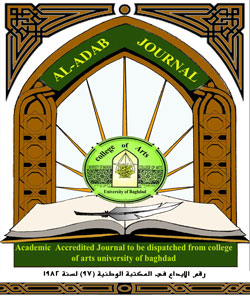التحليل المكاني للمواقع الأثرية ودورها في تطوير السياحة في مدينة بغداد
DOI:
https://doi.org/10.31973/aj.v0i114.1345Keywords:
/Abstract
Often described tourism as a spatial phenomenon related to the travel of rights from one place to another, so it becomes the subject of spatial analysis is the basis from which the majority of tourist analyzes, and features the majority of the big cities with a capacity size of its services recreational and advanced infrastructure, so are attractions for many foreign tourist groups from Besides its territory, which at the same time cities exporter tourist groups seeking tranquility and recreational activities, regions and cities and other areas, and this explains the movement of domestic tourism.
This study addresses one of the most important tourist activities namely archaeological tourism or historical, is the city of Baghdad from the cities that feature dimension and historical depth of civilization, embraces its shores are many historical places and archaeological buildings were, and still bear witness to the time periods experienced by the city, which could have attract large numbers of tourists as if they were rehabilitated and opened for tourism activity, and the provision of infrastructure and tourist facilities that serve this aspect, but what ails these places of neglect spontaneous or induced, the city has lost an important source of income
Downloads
References
2ـ آمنة أبو حجر، الجغرافية السياحية، دار أسامة للنشر والتوزيع، ط1، عمان، الأردن، 2011.
3ـ بشير إبراهيم الطيف وآخرون، خدمات المدن دراسة في الجغرافية التنموية، المؤسسة الحديثة للكتاب، طرابلس، لبنان، ط1، 2009.
4ـ عادل تركي فرحان، تخطيط وتنمية الخدمات والفعاليات السياحية للمناطق الأثرية وأثرها: منطقة الدراسة آثار عقرقوف، رسالة ماجستير، كلية الإدارة والاقتصاد، الجامعة المستنصرية، 2006.
5ـ عبد القادر سعدي الجميلي، تطوير الخدمات السياحية للاماكن التراثية، وأثرها في الطلب السياحي في بغداد، رسالة ماجستير، كلية الإدارة والاقتصاد، الجامعة المستنصرية، 2012.
6ـ عبد الله عطوي، جغرافية المدن، الجزء الثالث، دار النهضة العربية، بيروت، لبنان، 2003.
7ـ علي سالم الشواورة، جغرافية المدن، دار المسيرة للنشر والتوزيع والطباعة، عمان، الأردن، ط1، 2012، ص328.
8ـ ماهر يعقوب موسى وأياد علي فارس، التحليل المكاني للحرارة السطحية في مدينة بغداد باستخدام تقنية التحسس النائي ونظم المعلومات الجغرافية، مجلة كلية التربية، الجامعة المستنصرية، العدد، 6، 2005، ص600.
9ـ محمد جاسم محمد علي شعبان العاني، الإقليم والتخطيط الإقليمي، دار صفاء للنشر والتوزيع، عمان، الأردن، ط1، 2006.
10ـ محمد سلمان داود، إعادة تأهيل وتخطيط أنشطة السياحة الأثرية في مدينة بابل التاريخية أثرها في حركة التدفق السياحي : دراسة ميدانية ، رسالة ماجستير، كلية الإدارة والاقتصاد، الجامعة المستنصرية، 2012.
11ـ نعيم الظاهر، و سراب الياس ، مبادئ السياحة، دار المسيرة للنشر والتوزيع والطباعة، عمان ، الأردن، ط2، 2007.
المكتبة الالكترونية
1ـ المواقع الدينية في العراق، الدليل السياحي، السياحة الدينية، وزارة السياحة والآثار العراقية، هيئة الآثار، ص1 ــ 17، موقع الوزارة على الرابط:
http://www.tourismiq.com/index.php?ption=com-content&view=article&id=102&Itemid=141
2ـ الدليل السياحي، السياحة التاريخية والأثرية، وزارة السياحة والآثار العراقية، هيئة الآثار، موقع الوزارة على الرابط:
http://www.tourismiq.com/index.php?ption=com-content&view=article&id=2668
3ـ رؤوف الناصري، بغداد في تطورها العمراني، الموضوع 6/12/2013، س 12:05ص، على الرابط: http://www.iraqnla-iq.com/baghdad%20memory/nbtha2.htm
4ـ رؤوف محمد علي الأنصاري، السياحة ودورها في التنمية الاقتصادية والاجتماعية، الموضوع على شبكة الانترنيت تمت قراءته في 23/11/2013، س 01:06ص على الرابط: http://www.sutuur.com/inverstigations-ports/5491-news.html
5ـ رمزية بغداد التاريخية تغري بزيارة مواقعها الأثرية، 6/9/2013، س 03:38م على الرابط: http://www.qalbaliraq.net/vb/showtheead-php?s=e4a8b8b8d698bc69a
6ـ ويكيبيديا، الموسوعة الحرة، الموضوع على صفحة الانترنيت في 1/10/ 2013، س 09:33م على الرابط: http://www.wikipedia.org/w/index.php?title
7ـ مريم باسل ، تل حرمل قاعدة لإطلاق الصواريخ ومكب للنفايات، الموضوع على شبكة الانترنيت 18/12/2013، س 10م على الرابط:
http://www.qalatsaker.net/2%20ARTICLES/maraiam%20basel%209-12-2009.html
Downloads
Published
Issue
Section
License
Copyright and Licensing:
For all articles published in Al-Adab journal, copyright is retained by the authors. Articles are licensed under an open access Creative Commons CC BY 4.0 license, meaning that anyone may download and read the paper for free. In addition, the article may be reused and quoted provided that the original published version is cited. These conditions allow for maximum use and exposure of the work.
Reproducing Published Material from other Publishers: It is absolutely essential that authors obtain permission to reproduce any published material (figures, schemes, tables or any extract of a text) which does not fall into the public domain, or for which they do not hold the copyright. Permission should be requested by the authors from the copyrightholder (usually the Publisher, please refer to the imprint of the individual publications to identify the copyrightholder).
Permission is required for: Your own works published by other Publishers and for which you did not retain copyright.
Substantial extracts from anyones' works or a series of works.
Use of Tables, Graphs, Charts, Schemes and Artworks if they are unaltered or slightly modified.
Photographs for which you do not hold copyright.
Permission is not required for: Reconstruction of your own table with data already published elsewhere. Please notice that in this case you must cite the source of the data in the form of either "Data from..." or "Adapted from...".
Reasonably short quotes are considered fair use and therefore do not require permission.
Graphs, Charts, Schemes and Artworks that are completely redrawn by the authors and significantly changed beyond recognition do not require permission.
Obtaining Permission
In order to avoid unnecessary delays in the publication process, you should start obtaining permissions as early as possible. If in any doubt about the copyright, apply for permission. Al-Adab Journal cannot publish material from other publications without permission.
The copyright holder may give you instructions on the form of acknowledgement to be followed; otherwise follow the style: "Reproduced with permission from [author], [book/journal title]; published by [publisher], [year].' at the end of the caption of the Table, Figure or Scheme.












